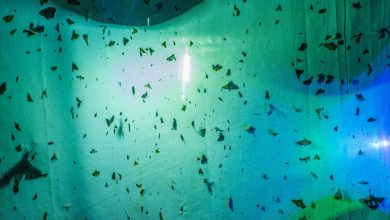Sheltering in Kyiv While Showing in New York

In a showroom in the NoHo section of Manhattan, a laptop sat on a table, tucked behind a rack of knitwear by the Ukrainian label 91 Lab. The computer streamed CNN silently. Ominous footage from the streets of Kyiv, the capital of Ukraine, caught the eye of Alina Bairamova, the fashion industry coordinator for Ukrainian Fashion, a showcase for Ukrainian designers.
“I’m sorry,” Ms. Bairamova said, adding that the scene was very near her mother’s house.
The footage was from the previous day, and Ms. Bairamova’s mother, who works at a veteran’s hospital in Kyiv, was safe. Still, it had been a horrific few days.
She applied lip balm. “For dehydration,” she said. “From crying.”
Ms. Bairamova, 46, arrived in New York on Feb. 17 with one suitcase and a Ziploc bag of toiletries. She was expecting a 10-day work trip spent wooing buyers and promoting the six designers in a showcase called Ukrainian Fashion.
Now it was unclear if or when she will return to Kyiv.
The Russian invasion of Ukraine had blindsided her. “Five days ago, that scenario seemed unheard-of,” she said.
Jen Sidary, the founder of Ukrainian Fashion, was less surprised. “I’ve been panicking since November,” she said as she sat beside Ms. Bairamova. Ms. Sidary said that despite her own anxieties about a possible invasion, she was determined to follow through on the event.
Ms. Sidary said proudly that every piece from every designer had arrived in the United States in time for the showcase’s opening on Feb. 23.
“Thanks to Jen, God and DHL,” Ms. Bairamova said with a laugh. “In that order.”
A veteran of the fashion industry who has worked stints at Zappos and Vivienne Westwood, Ms. Sidary, 49, has become a champion of Ukrainian fashion in the last two years.
When she lost her job in the middle of the pandemic, she said, friends urged, “Girl, come live with us in Kyiv — it’ll be so fun!”
One of them was Dominique Piotet, the chief executive of an Innovation Park incubator program called UNIT.City, whom she had met through Tony Hsieh, her former boss at Zappos. In November 2020, Ms. Sidary accepted Mr. Piotet’s invitation to stay with him.
Ms. Sidary fell in love with Ukraine. “I felt this immediate sense of ‘I am home,’” she said in a slow Southern California accent. She loved its thriving fashion scene, and she was taken with the country’s wide variety of cuisines and a meticulous attention to detail in design.
In July 2021, Ms. Sidary secured a grant from the USAID Competitive Economy Program that enabled her to start the first Ukraine Fashion event in September. The showcase received another grant in 2022 to help fund this year’s showcase.
Ms. Sidary learned of the Russian invasion while eating with Ms. Bairamova at Kiki’s, a Greek restaurant on the Lower East Side. They were joined by two other Ukrainian women in fashion, Valery Kovalska, a designer, and Anya Vasylenko, the director of wholesale for Issey Miyake.
During dinner, Ms. Sidary received a text from David Anderson, an executive at USAID, saying that Ukraine was being invaded. She took Ms. Bairamova’s hand and broke the news to the table. “We spent the rest of the evening together, obviously having cocktails because what else do you do?” Ms. Sidary said.
All four women immediately began contacting their friends and family in Ukraine via Telegram and WhatsApp. Ms. Sidary said that she has been in constant contact with all six of the designers in the showcase.
“I’m like their mom, calling to make sure everyone’s OK,” she said in the showroom, as she recalled the dinner.
On Friday around noon, Ms. Sidary and Ms. Bairamova called Alina Kachorovska, a footwear designer featured in Ukrainian Fashion, from the showroom. Ms. Kachorovska was in a bomb shelter in her apartment building in Kyiv with her husband, three children and a neighbor.
Understand Russia’s Attack on Ukraine
What is at the root of this invasion? Russia considers Ukraine within its natural sphere of influence, and it has grown unnerved at Ukraine’s closeness with the West and the prospect that the country might join NATO or the European Union. While Ukraine is part of neither, it receives financial and military aid from the United States and Europe.
Are these tensions just starting now? Antagonism between the two nations has been simmering since 2014, when the Russian military crossed into Ukrainian territory, after an uprising in Ukraine replaced their Russia-friendly president with a pro-Western government. Then, Russia annexed Crimea and inspired a separatist movement in the east. A cease-fire was negotiated in 2015, but fighting has continued.
How did this invasion unfold? After amassing a military presence near the Ukrainian border for months, on Feb. 21, President Vladimir V. Putin of Russia signed decrees recognizing two pro-Russian breakaway regions in eastern Ukraine. On Feb. 23, he declared the start of a “special military operation” in Ukraine. Several attacks on cities around the country have since unfolded.
What has Mr. Putin said about the attacks? Mr. Putin said he was acting after receiving a plea for assistance from the leaders of the Russian-backed separatist territories of Donetsk and Luhansk, citing the false accusation that Ukrainian forces had been carrying out ethnic cleansing there and arguing that the very idea of Ukrainian statehood was a fiction.
How has Ukraine responded? On Feb. 23, Ukraine declared a 30-day state of emergency as cyberattacks knocked out government institutions. Following the beginning of the attacks, Volodymyr Zelensky, Ukraine’s president, declared martial law. The foreign minister called the attacks “a full-scale invasion” and called on the world to “stop Putin.”
How has the rest of the world reacted? The United States, the European Union and others have condemned Russia’s aggression and begun issuing economic sanctions against Russia. Germany announced on Feb. 23 that it would halt certification of a gas pipeline linking it with Russia. China refused to call the attack an “invasion,” but did call for dialogue.
How could this affect the economy? Russia controls vast global resources — natural gas, oil, wheat, palladium and nickel in particular — so the conflict could have far-reaching consequences, prompting spikes in energy and food prices and spooking investors. Global banks are also bracing for the effects of sanctions.
Ms. Kachorovska said that she was trying to remain optimistic. “Millions of people are now in this situation all over the country,” she said. “So, we are not alone, you know?”
“I have your shoes on, girl,” said Ms. Sidary, who was wearing a pair of white chunky Kachorovska boots. “I have your shoes on.”
“Thank you,” Ms. Kachorovska said.
Ms. Sidary then called Ivan Frolov, whose heavily rhinestoned Bob Mackie-like creations hung on a rack nearby. Mr. Frolov was exhausted, having spent 25 hours traveling to western Ukraine.
With occasional translation help from Ms. Bairamova, Mr. Frolov expressed disbelief at the invasion, praised Ukraine’s military and stressed the need for more international help.
As she listened to Mr. Frolov, Ms. Sidary wiped tears away and rested her face in her hands. Her nails were painted a vibrant metallic fuchsia.
She assured Mr. Frolov that she would take his garments back to her apartment in West Hollywood, Calif. “No, it’s fine,” she said into the phone, when he was concerned she would have to pay for an extra bag. “I’m a Medallion member”
While Ms. Sidary stepped out for a cigarette, Ms. Bairamova called another designer from the showcase, Elena Burenina, who is also a close friend.
Ms. Burenina had chosen to remain in Kyiv, where she continued to sketch, cut patterns, sew and fulfill orders, even as her country was under attack. She said she would consider leaving the country only if Vladimir Putin took power and life became completely unbearable.
“Elena believes that beauty will save the world,” Ms. Bairamova said, paraphrasing the words of her friend.



